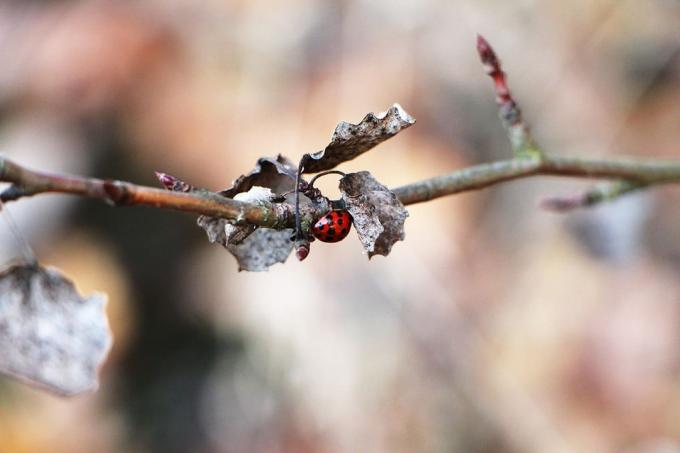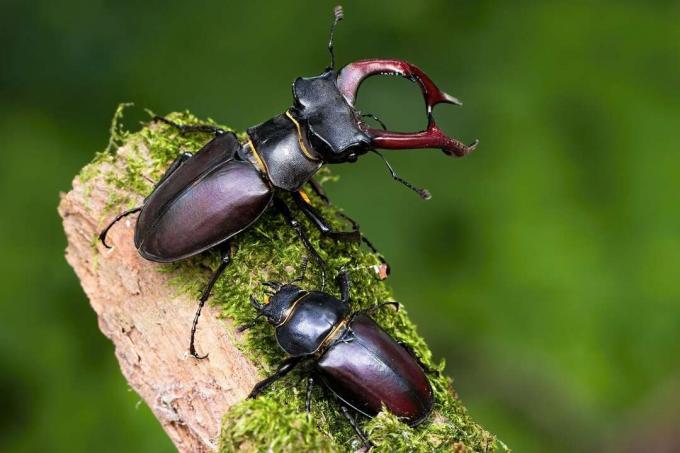

Table of contents
- Ladybird Species (Family Coccinellinae)
- aphids
- other insects
- Other diets
- cannibalism
- water demand
Ladybugs are among the most popular and well-known insects of all. For some gardeners, the question arises as to what else the beetles like to eat besides aphids or whether they need something to drink.
Ladybird Species (Family Coccinellinae)
The best known are the seven-point (Coccinella septempunctata) and the two point (Adalia bipunctata). Ladybugs are almost always named for the number of spots on their elytra. The basic color can be red or yellow, rarely black. There are some types with no points at all. Some beetles are so variable in their coloring that it is difficult to tell the individual species apart.
A notice:
In recent years, the Asian ladybird (Harmonia axyridis) has become increasingly common and is competing with the native species. Due to various characteristics, it can reproduce and assert itself better than its European relatives.
aphids
Most ladybird species feed on aphids and their larvae. They consume large amounts of the pests. While native ladybugs eat up to 60 aphids a day, the aforementioned Asian ladybug can eat up to 270 aphids a day. Ladybugs can decimate an aphid colony in a very short time. Not only do the beetles themselves eat the lice, the larvae are also very hard-working pest eaters.

A notice:
It is always worthwhile for gardeners to have as many ladybugs as possible in the garden and to encourage them.
Not every species of ladybird hunts for aphids on every plant. In fact, some of the beetle species specialize in certain lice or plants. There are many ladybirds on coniferous trees that hunt conifer aphids there.
other insects
In addition to aphids, the food of ladybugs includes other soft and small insects:
- Larvae of sawflies, butterflies and other beetles
- scale insects
- some smaller bug species
The availability of food is important when choosing food. Ladybugs are then not particularly picky and eat what they can reach or hunt down. The same applies to the larvae of the beetles.
Other diets

In addition to the ladybugs, which mainly eat insects, there are also some species that have a different diet. However, these are rarer and less conspicuous than an aphid colony with ladybirds.
- twenty-four point(Subcoccinella vigintiquatuorpunctata): Plants (alfalfa, clove, clover, potatoes), can cause severe damage
- Spruce Globe Ladybug(Scymnus abietis): mites as well as aphids
- Black ball ladybug (Stethorus punctillum): spider mites
- twenty-two point(Psyllobora vigintiduopunctata): powdery mildew
- Sixteen-spotted ladybug(Halyzia sedecimguttata): powdery mildew
cannibalism
Very many species of ladybirds behave cannibalistic towards eggs and larvae of their own kind. This means they don't make much of a difference if they continue to eat aphids or prefer the eggs or even the larvae of another ladybug. What they are unable to do because of their hard elytra is eating other adult ladybirds. The same applies to other beetle species. Cannibalism within their own species is very fatal for ladybugs, as it allows them to become infected with parasites that can kill them.
water demand
Like other animals, ladybugs also have a certain need for liquids. However, this is often breastfed in a completely natural way. On less dry days, the moisture of the prey is sufficient. In addition, the beetles can pick up dew or raindrops. It is not necessary to offer ladybugs a special insect waterer in the garden. Especially since water points for insects often become traps in which they can drown. Moist areas in the garden that do not dry out even in dry conditions and are overgrown with dense moss are much more helpful. There all kinds of insects can get liquid.
A notice:
If there is to be a watering hole for insects, it must be secured against drowning with several large stones, wood or moss.
 Home editorial office
Home editorial office
Learn more about insects

Identify beetles with pincers: 10 native species
Beetles are impressive insects. There are large and small, dark and dazzlingly colorful species. Some have pincer-like upper jaws for crushing or holding prey. The stag beetle is the largest among them. We present 10 native beetles with pincers.

Insect Hotel Filling: 10 filling materials
An insect hotel in your own garden offers numerous insects artificial shelter, nesting and wintering opportunities. They are more than necessary, because they are disappearing more and more as a result of massive human intervention in nature. They are essential for survival.

Insect species: which insects are there in Germany?
In Germany there are around 30,000 species of insects in various shapes and colours. Of these, there are some that are better known than others. In this article you will find a large list of native insects that shape the image of the country.

Fight field crickets in the lawn | What do crickets eat?
On warm summer days you can hear the chirping of field crickets. In places, the skittish insects appear in heaps. They dig holes in the lawn and their singing can be distracting. What do these strange insects eat? How do you get rid of them?

Spiders in Germany | Identify 18 species of spiders
Spiders cause disgust and disgust in many people. It often helps to take a closer look at these fascinating eight-legged creatures. Identify species that are common in Germany with us and learn about their appearance and habits.

46 bee-friendly plants by flowering season
With bee-friendly plants in the garden or on the balcony, wild bees and honey bees can make an important contribution. Both are threatened with extinction. In addition, you also support many other useful insects and birds.



